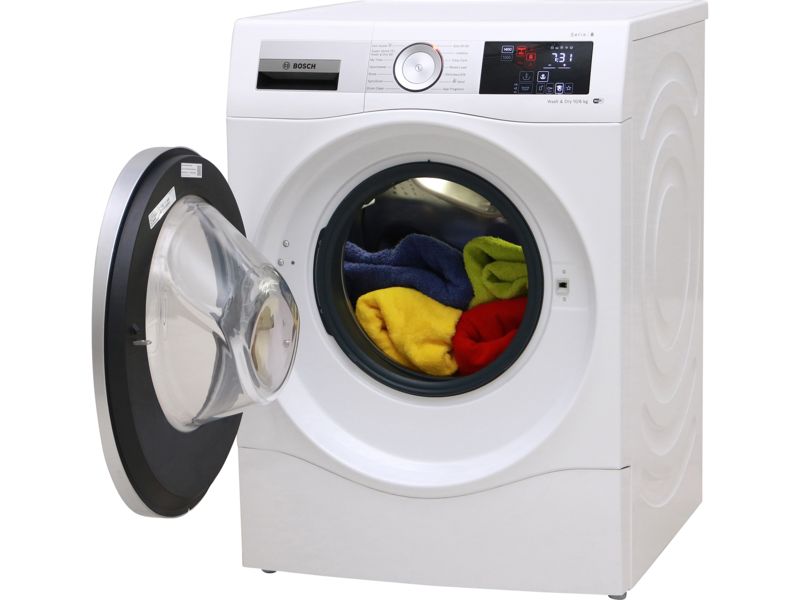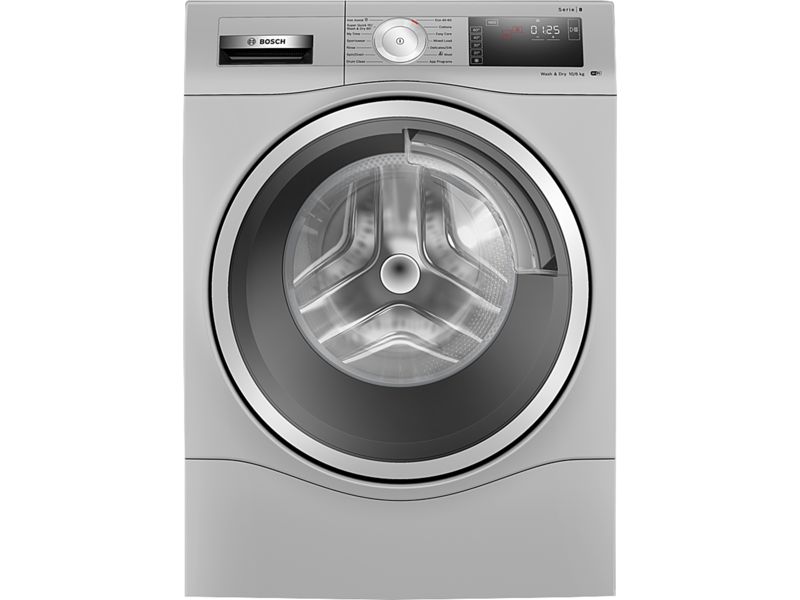Washer-dryer features explained

Below, we explain the key features to consider when choosing a washer-dryer, plus a range of helpful extras that some machines offer and you may like to look out for.
Once you've decided what type of washer-dryer is right for you, go straight to our washer-dryer reviews to find our expert impartial verdict on more than 100 of the latest models.
Essential washer-dryer features
Washing programs
All washer-dryers offer a suite of standard washing programs, which includes settings for cottons, man-made materials and delicate fabrics at a range of different temperatures.
Most models have additional options, such as pre-wash, spin and extra rinse, and some have special cycles designed for specific scenarios, such as hand-wash, curtains, sportswear or even trainers.
Drum size/capacity
Washer-dryers are all of a very similar size on the outside, but their washing capacities vary between 4.5kg and 7kg of laundry, and they can dry 2.25kg to 5kg. An extra kilogram equals around five T-shirts or one large sheet.
Bigger isn't necessarily better when it comes to capacity. If you don't fill up the drum, the larger washer-dryers can be less efficient, because they use so much water in each wash. If you wash or dry with a full load in a larger machine, you use less energy, water and time per item.
Filter
All washer-dryers have a filter, which catches fluff whipped up when drying, as well as bits of debris. They need to be cleaned regularly, which can be a pain on some models because they are often close to the ground and can be fiddly to open.
Condenser
The condenser in a washer-dryer cools moist, hot air inside the machine, producing water which pours down the drain.
This process uses a lot of water itself, making some washer-dryers a poor choice for people with a water meter.
Energy ratings
Washer-dryers are rated between A+ and G for energy efficiency, with A+ being the most efficient. Although the ratings officially go down to G, in practice you won't see new machines below C in the shops.
We assess the energy and water use of every washer-dryer we test in the Which? test lab, and give each one a star rating for energy efficiency, as well as an estimate of how much each will cost to run.
To compare washer-dryers for energy use and running costs, go to our washer-dryer reviews.

Useful extra washer-dryer features to look out for
Quick-wash program
Most machines have a quick cycle of 50 to 70 minutes (standard washes are usually nearer two hours) which work best for clothes that aren't too dirty.
Woollens program
This is a gentler program for cleaning wool-mixture clothes, which can become bobbly on normal programs.
Only items marked as 'pure new wool' and 'washable', 'pre-shrunk' or 'non-matting' should be washed using the wool program.
You should wash all other types of wool with a handwash program or by hand.
Reduced-ironing program
We've found that there can be little difference between a load washed on an easy-iron program and one washed on a standard cycle.
Using lower spin speeds can help to reduce creases.
Handwash program
This is intended for garments made of delicate materials such as cashmere, angora and silk.
Like the delicates program, it washes clothes more gently than the normal setting, so they don't snag, matt or shrink.
Fuzzy logic and other automatic wash systems
Many washer-dryers have 'fuzzy logic' sensors that automatically vary the wash program according to how big or dirty the load is.
Bioprofile, biostage or protein eliminators are just some of the names different companies call these stain-removing features. Aquatronic wash, 3D AquaSpa, Showerwize, Power Jet and other similar terms refer to features that spray water to soak clothes and distribute detergent more effectively.
All these features vary in how effective they are. One fuzzy logic system might be much more sophisticated than another. So the safest option is just to check out our washer-dryer reviews to see how each one scores in our tough cleaning tests.
Extra rinsing
Many washer-dryers are poor at rinsing, so the ability to add an extra rinse can sometimes ensure more detergent is removed from laundry. This is useful for people with eczema, sensitive skin or allergies.
If you have a problem with undissolved detergents, consider switching to liquid detergents, particularly for quick-wash programs.
Variable spin speed
This lets you vary the spin speed of the machine to protect woollens, handwash-only clothes and delicate items from damage.
It's useful if the default spin speed for your machine is higher than 1,000rpm.
Delayed start
This allows you to set the washer-dryer to automatically start in a few hours time, which is useful if you want the machine to work while you are out of the house, or overnight. Some washer-dryers with this feature let you set the machine up to 24 hours in advice, while others only allow smaller delays.
If you use delayed start at night, fit a smoke alarm nearby.
Electronic display
This helpful feature lets you check which stage of washing or drying a program has reached and how long it has left to run.



